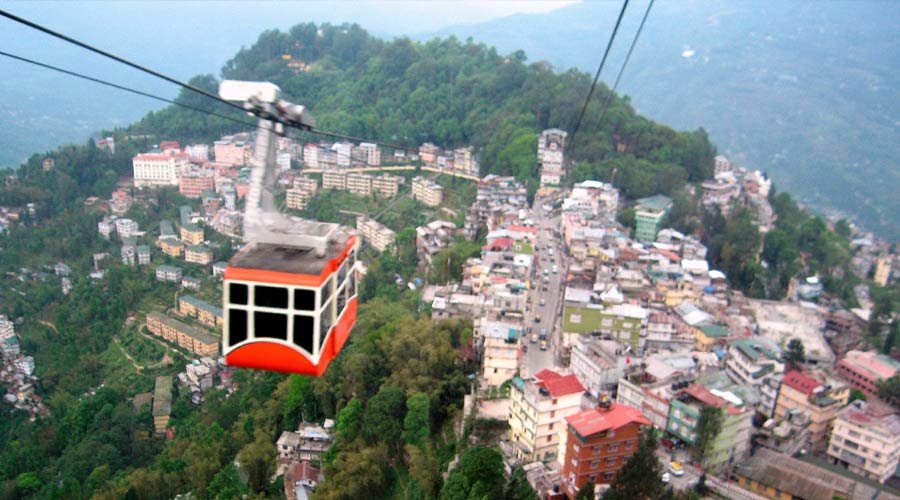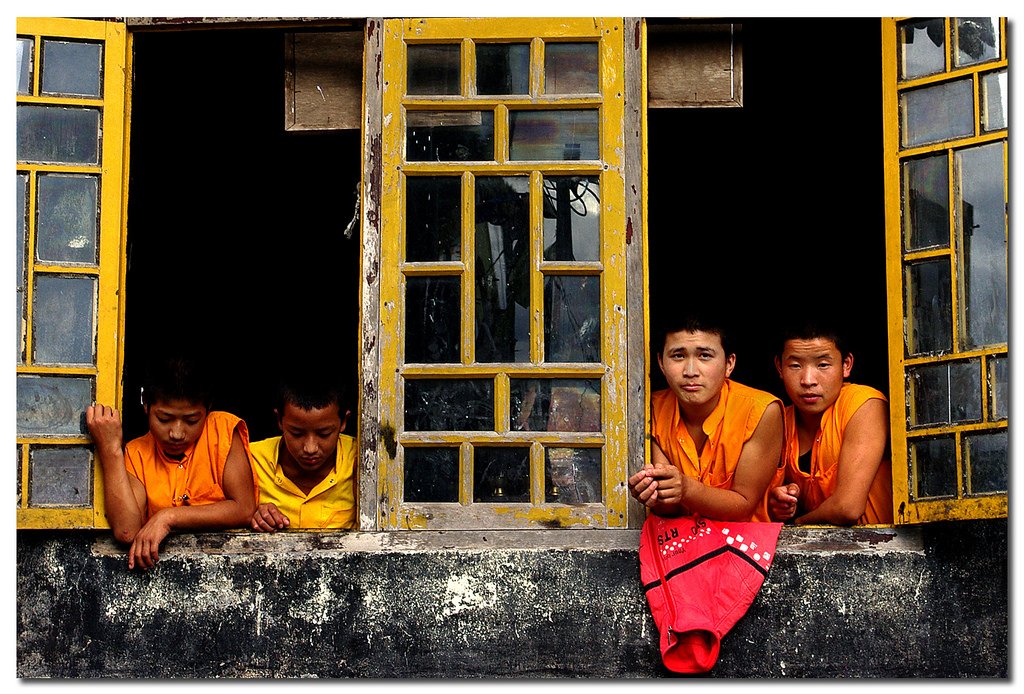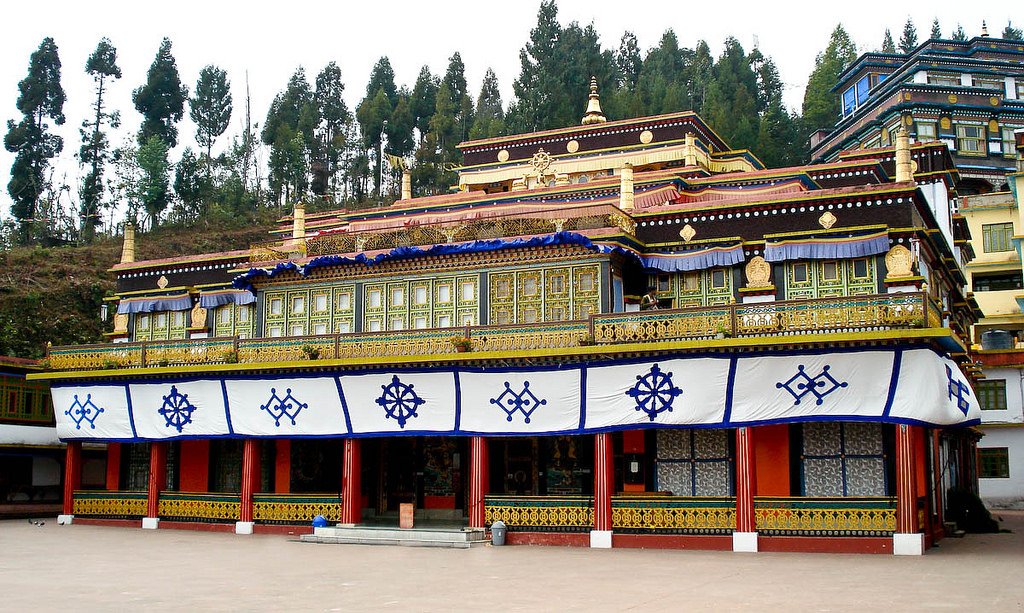“Sikkim: Where Nature Smiles”
A Himalayan wonderland, Sikkim is nestled in the foothills of the eastern Himalayas and nature has gifted this state with unique beauty. The state is bestowed with a greater variety of vegetation and undisturbed valleys, five climatic zones, total sanitation, peaceful environment, hospitable and humble people and a rich cultural heritage – which is unmatched and would be hard to find anywhere else. Among its mountains is the fabulous Kanchenjunga is the third highest mountain in the world. Sikkim is also the least populous state in the Indian union. Gangtok, the capital of Sikkim is situated at a height of over five thousand feet above sea level.
Sikkim tourism has lots to offer a discerning traveler. Foreigners here can visit Gangtok, Rumtek, Phodong, Pemayangtse and the Yuksom -Zongri trekking route on the basis of restricted area permits which can be obtained. There are numerous Lakes and Monasteries which make the hill station vibrant and lively. To experience complete rejuvenation, Sikkim is a perfect place to travel for holiday.
Things to keep in mind before traveling
-
Sikkim has certain entry restrictions. In fact the whole of Sikkim is under restricted area regime due to its proximity to neighboring countries like China. And therefore all foreign nationals require Restricted Area Permit(RAP) to visit any part of Sikkim. This permit is also known as Inner Line Permit (ILP). Indians, however, do not require this.If you are a national of Pakistan, China, Myanmar or Bangladesh, then it gets a little more difficult to enter Sikkim. You must get a written approval from Ministry of Home Affairs, Government of India, New Delhi before the Restricted Area Permit can be issued. And there are other restrictions for all including Indians for few specific places in Sikkim. Certain areas like Tsomgo Lake, Dzongri etc are defined as Protected Areas and have special army deployment. Both foreigners and Indians require a separate permit known as Protected Area Permit (PAP) to visit such places. But few protected border areas like Nathulla are not accessible to foreigners at all, while Indians can still visit with the Protected Area Permit.How to get Restricted Area Permit (RAP) or Inner Line Permit (ILP)?Restricted Area Permit is applicable only for foreigners. It is free of cost. You must have a valid Passport and an Indian visa. With proper documentation, it takes less than 30 minutes to get the permit across the counter.Restricted Area Permit (ILP) can be manually obtained at the following places:
- New Delhi – Sikkim House, Panchsheel Marg, Chanakyapuri
- Kolkata – Sikkim House, 4/1 Middleton Street
- Siliguri – Office of Sikkim Nationalized Transport, Sevoke Road
- Bagdogra Airport – Sikkim Tourism Counter on arrival X No longer issued (Updated Mar 2017)
- Rangpo checkpoint (on the way to Gangtok or East Sikkim).
NOTE: It takes only few minutes if you have all documentation in place.
- The weather in the north-east is pretty unpredictable, so be prepared to have delays due to the bad weather.
- Most roads in the Northeast are being converted into double-lane so right now they aren’t in the best shape.
- Locals are friendly and helpful. Be patient as not everyone will know fluent Hindi or English.
- Most cell phone networks don’t work well, so inform your family or friends about your whereabouts whenever possible.
- Don’t forget to carry some ready to cook food packets or instant noodles if you’re strictly a vegetarian.
- Carry extra batteries, power banks and most importantly warm clothing.
- Keep at least a couple of extra days in hand in case of any problems like landslides and bad weather on your way.
Almost All the modes of transportations are available to visit Sikkim. This Paradise on Earth is well connected by airways, railways and roadways. In spite of being a hilly state, transportation of Sikkim is comfortable and more frequent to enjoy the ride on the world’s most beautiful valley.
BY AIR
The airport located nearest to Sikkim is Bagdogra Airport of West Bengal which is only 124 Kms away from Gangtok. India’s national carrier, Indian Airlines including almost all other domestic airlines such as Jet Airlines, Air Deccan run regular flights from the important cities of India such as Kolkata, Delhi etc. Bagdogra is also connected with Gangtok by daily helicopter service operated by Sikkim Tourism development Corporation and it will take only 20 minutes to reach Gangtok from Bagdogra. This helicopter service is subjected to the weather conditions.
BY TRAIN
New Jalpaiguri and Siliguri are the two rail stations nearest to Sikkim located in West Bengal. NJP is 125 Kms and Siliguri is 114 Kms from Gangtok and is well connected to all the major cities. Ticket reservation facilities are available from Sikkim Nationalized Transport office in all working days.
BY ROAD
The lifeline of Sikkim, which is National Highway 31A connects gangtok with Siliguri and this picturesque highway runs through the lush green forests along the bank of river Teesta on one side and sky touching mountain ranges of Eastern Himalaya on other side. This unique ride of almost two hours will gives you the opportunity to enjoy the valley carpeted with numerous wild flowers. Regular bus service operated by S.N.T. and adequate number of private buses, jeeps and taxies are available from morning to evening at reasonable rate and you can have a very comfortable journey. From Siliguri you can catch jeeps and taxies to reach almost all the important tourist destinations located in both South and West Sikkim. You can also hire taxies and jeeps to travel to your destination of choice at reasonable rate. Most of the reputed destinations of siikim are interlinked by motor able all seasons roads.
- Sikkim has already become the first fully organic state of India
- Nathu La mountain pass at an altitude of around 4,310 m connects India with China’s Tibet Autonomous Region
- There are 5 highly popular hot water springs in Sikkim, and most of them located in amazingly tranquil environs
- Sikkim boasts about 1/3rd of the total angiosperm of India!
- There are 690 species of vivid colored butterflies.
- Sikkim records as many as 533 species of bird, including some rare species.
- Siddheshwar Dham in Sikkim has 108-foot-tall statue of Lord Shiva with 12 jyotirlingams girdled across.
- If you like Rhododendron forests lining the beautiful Himalayan Valleys, Sikkim is your place to be.
- Sikkim is the only Indian state with monasteries of all 4 schools of Buddhism.
- A special seat called ‘Sangha’ in the Sikkim Legislative Assembly looks after the ecclesiastical affairs.
- There are around 200 monasteries, churches, temples, gurudwaras, and mosques in this tiny state!
- Sikkim’s state animal is the Red Panda—an endangered species.
- When the whole country prefers paying homage to the soldiers on a specific day or two, Sikkim has a temple built to honor a soldier.
- This Indian State has the maximum foreign population.
- An Indian state but not by birth.
Top Places To Visit
- Gangtok:
Believe it or not, but resisting the alluring charm and appeal of Gangtok is almost impossible for anyone! The capital city of Sikkim, Gangotk is nestled in the Eastern Himalayas and is one of the kaleidoscopic tourist destinations in the state. - Yuksom:
Located in the Western parts of Sikkim, Yuksom is the origin of several enthralling treks into the Himalayas or the magical Kanchenjunga. The once a capital of Sikkim, this hamlet is more known for its pristine beauty and rustic appeal. - Tsomgo Lake:
On a visit to Gangtok, do not miss the chance to visit the Tsomgo Lake or the Changu Lake! Located only 38km from Sikkim’s capital, it lies at an altitude of 12,400ft and is one of the highest lakes in India. - Nathula Pass:The once a part of the historic ‘Silk Road’, a visit to Nathu La is a must in any of the Sikkim travel packages. One of the highest motorable pass in the world, this amazing pass is located at a towering height of 4,310m above the sea level and connects Sikkim with Tibet.
- Pelling:If you are an ardent fan of the captivating Himalayan Range, Pelling is the destination for you! It is from this Sikkimese town, one can have the best views of the Himalayas and the Kanchenjunga Peak, and can experience the best of their Sikkim holidays.
- Lachung:
Lachung has multiple reasons to make you fall in love with it! While its location at an enthralling height of 8,610ft makes it a popular snow-destination in Sikkim, its untouched and surreal beauty makes it one of the scenic as well as charming tourist places in Sikkim. - Ravangla:
Nestled amidst the Maenam and Tendong Hills, Ravangla is among the best places to visit in Sikkim; especially in the southern part of the state. A scenic town between Gangtok and Pelling, this hill-town also hosts some of the most popular treks in Sikkim. - Rumtek Monastery:
Counted amongst the largest monasteries in Sikkim, Rumtek Monastery is also one of the oldest monasteries in the state. An ode to the Buddhist cultures and traditions, this monastery is located near Gangtok and is also known as the ‘Dharma Chakra Centre’. - Namchi:
Translated into the native Tibetan language, Namchi means the ‘top of the sky’. And on a visit to this magnificent Sikkimese city, this will be proved! Located around 92km from Gangtok and at a height of 1,675m above the sea level, it is also one of the most gorgeous cities in the state. - Do-Drul Chorten
The largest Stupa in Sikkim, Do Drul Chorten was built in 1945 under the leadership of Truslshi Rimpoche. Holding a high prominence amongst all the religious sites in the state, this stupa is laced with 108 Mani Lhakor prayer wheels and is an ultimate place to connect with the essence of one’s inner-self. - Jawaharlal Nehru Botanical Garden:
Located within a close proximity with the Rumket Monastery, this lush and verdant botanical garden is the home to several rare and exotic species of plants and trees. Some of the orchids found in this garden are indigenous to only this part of the world and holds high medicinal and commercial value as well. - Zuluk:
Touching a towering height of 10,000ft, Zuluk is one of the least discovered destinations in the entire of Sikkim. Located on the ancient ‘Silk Route’, this quaint Sikkimese village takes the pride of being a vintage point to enjoy panoramic views of the Mt Kanchenjunga. - Namgyal Institute of Tibetology:
Nestled amidst lush and evergreen thickets, the Namgyal Institute of Tibetology is an ideal centre to learn about Buddhist cultures and traditions. Established in 1958, this institute is in fact the home to the largest collection of Tibetan preaching outside Tibet, and this include relics from 11th and 12th century collected from different parts of the world. - Yumthang Valley:
A visit to Yumthang Valleys it truly a colorful affair! Located at an elevation of 3,500m, this scenic valley is the home to several exotic, rare and wildflowers. It is often said, one who visits this quintessential valley, often gets pleasantly affected by its treacherous colors and alluring beauty!
Come the monsoons, the entire valley blooms at its best and displays the most enchanting colours of the nature. Primrose, cobra-lilies, louseworts, and cinquefoils are some of the most commonly found species in Yumthang - Gurudongmar:
Last, but not the least in this list is the Gurudongmar Lake! One of the highest fresh-water lakes in the world, this gorgeous place to visit in Sikkim is located at a towering height of 17,800ft and is also known as Tso Lhsmo Lake.
Best Time To Visit North Sikkim
The temperature in this town during the months of May to September is moderate with the maximum temperature being 28 to 30 degrees Celcius. North Sikkim experiences mild to heavy rainfall during the months of July and September. The weather during the winters is very harsh with the temperatures falling to sub-zero and it is not advisable to visit this town during this time.
Monthly Weather in North Sikkim
| Month | Avg. Minimum (°C) | Avg. Maximum (°C) |
|---|---|---|
| January | -6 | 15 |
| February | -3 | 16 |
| March | 1 | 17 |
| April | 5 | 20 |
| May | 6 | 23 |
| June | 8 | 27 |
| July | 8 | 26 |
| August | 7 | 30 |
| September | 6 | 25 |
| October | -0 | 27 |
| November | -5 | 20 |
| December | -5 | 17 |
Summer (March – June) The summers are the best time to visit North-Sikkim as the weather, though on the cooler side, is pleasant.
Monsoon (July – September) The monsoons, though not ideal, are a good time to visit North-Sikkim. It receives moderate showers and the rains only add to its exuberant charm.
Winter (October – February) The winters are most definitely not the best time to visit North-Sikkim as it gets extremely chilly due to its location on a high altitude.
Day 1: Arrive at Gangtok and check-in to your hotel. The day is free for you to walk the streets, explore the city, and soak in the holiday mood. You may consider spending time at MG Marg and Lal Bazaar.
Day 2: Have breakfast and leave for Lachen (from Gangtok – 109km / 3 hours 30mins), latest by 10 AM. Enjoy the scenic beauty on your way to Lachen. After reaching Lachen, check-in to your hotel. Explore the small town, and soak in the culture of these hills.
Day 3: drive to Thangu (13,500 ft, 31Kms from Lachen). Pass through Chopta Valley (13,200 ft). It is rich in alpine vegetation. After this, drive towards Gurudongmar Lake(17,000ft). Gurudongmar Lake is one of the highest situated lakes in North Sikkim. Only Indian Nationals are allowed here. After visiting Gurudongmar Lake, head to Lachung for the night.
Day 4: Head towards Yumthang valley, which is nearly 26 kilometers, an hour’s drive, from Lachung. It is situated at an elevation of 11800 feets. On the way from Yumthang valley, one may visit the famous hot spring which is known for its curative properties. Other noteworthy places include Katao and Yumesamdong (also known as Zero Point). Zero Point, is further northwards of Yumthang and requires an additional permit to be obtained from Gangtok. On your way from Lachung to Gangtok, stop at the Seven Sisters Fall for a while, as it falls about midway to Gangtok.
Day 5: Drive towards Tsomgo Lake and Baba Mandir. Tsomgo Lake (12,400 ft./ 39 km from Gangtok) is one of the highest altitude Himalayan Lake. This beautiful, oval shape lake is almost 1 km long with an average depth of 50 ft. After this, drive up to Baba Harbhajan Singh Memorial (13,000 ft / 15 km / 30 Mins) also known as Baba Mandir.
Day 6: Cover Namchi and then head towards Ravangla. On your way to Namchi you will cross Temi Tea Garden which is Sikkim’s sole Tea estate. The tea is marked by its exotic odour and flavour. You may stop at one of the restaurants on the way, buy tea varieties, take a walk in the tea estate, as well as get photos clicked in local attire.
Day 7: Drive to Pelling and Beyond. Visit Kanchenjunga Falls and Khecheopalri Lake. This lake is one of the sacred Buddhist lakes and it is believed that whatever is wished in front of the lake comes true. You may also stop at Rimbi Waterfalls and Rimbi Power Project on the way.
Day 8: Visit Pemayangtse Monastery. After spending some time there, head to Rabdentse Palace Ruins. Rabdentse was the ancient capital of Sikkim. The palace ruins also give an amazing view of the valley.
Day 9: Head back to home with some great memories.













